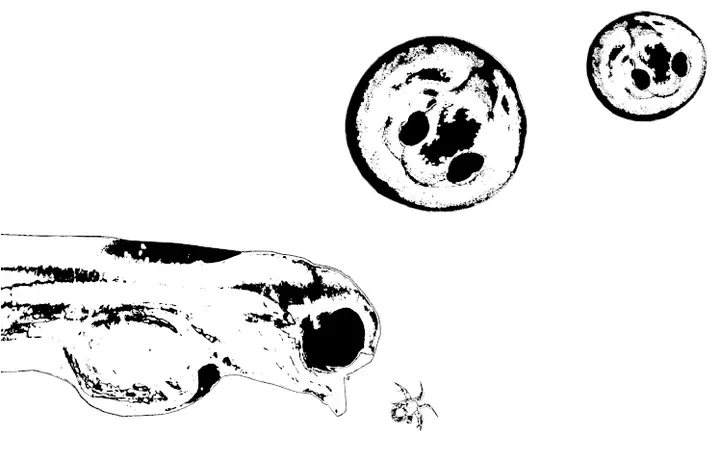Bottom-up effects on growth and survival of larval Atlantic herring (Clupea harengus) from the North- and Baltic Seas
 Image credit: Björn Illing
Image credit: Björn Illing
Abstract
The stability of marine fish populations is, next to natural or fishing mortality, based on the annual recruitment of the young-of-the-year. The variability in the number of these recruited fish is determined by effects of several abiotic and biotic factors on the vulnerable early life stages (eggs and larvae). Predation, the main driver of mortality, acts contrarily to the energy flow from “top-down", whereas factors such as temperature, salinity or prey availability primarily operate from “bottom-up".
In this thesis, a closer look was taken on the effects of these bottom-up factors on Atlantic herring (Clupea harengus, L.) larvae from the North and Baltic Seas by measuring their influence on vital rates such as growth, survival, metabolism, nutritional condition as well as feeding and swimming activity under different conditions.
In experiments simulating match or mismatch situations with spring phyto- and protozooplankton blooms, spring-spawned Atlantic herring yolk sac larvae from the Baltic Sea were observed to directly benefit from a spatio-temporal match with microalgae and dinoflagellates. In particular, it could be observed that herring larvae initiated their digestive system more rapidly (precocious production of trypsin) and possessed an earlier and enlarged “window of opportunity" for foraging on larger prey, both supporting the change from endogenous to exogenous feeding. However, survival spans could not be prolonged by microalgae and dinoflagellates after yolk resources had been depleted. Yet, trials with additional, larger prey (copepods), continuously supplied during rearing, suggested an indirect, trophodynamic benefit.
In further trials with older spring- (Baltic Sea) and winter-spawned (North Sea) herring larvae, previously reared beyond the first-feeding stage, the physiological and behavioral effects of prey scarceness were investigated during a mismatch with copepod prey. Larvae that were confronted with prey-poor environments reduced their swimming and feeding activity dramatically within 2-4 days, concomitant with decrements in nutritional and somatic condition. After a couple of days without prey, larvae were observed to have their standard metabolic rate down-regulated up to a third. Using the obtained swimming activity data in an individual-based model simulating the winter condition (7 °C), the survival of e.g. 25-mm larvae was observed to be reduced from 8 to 6 days, assuming no metabolic down-regulation. In the laboratory experiments, exacerbated reductions in performance parameters were found in prey-poor treatments under warmer spring conditions (10 °C), resulting in a more pronounced selection against smaller larvae.
Temperature can influence larval fish condition and performance by affecting both physiological (biochemical reactions) and physical (e.g. water viscosity) levels. When larval herring were reared under ad libitum conditions at three different temperatures (7, 11, and 15 °C), their growth rates and morphology were strongly depending on the rearing temperature with highest growth and fastest development found at the highest temperature. Critical swimming speed (Ucrit) was tested throughout ontogeny and observed to increase exponentially after yolk-sac absorption. Herring larvae entered the transition to less viscous, and hence advantageous environments (Reynolds numbers > 300), at smaller body sizes when kept at warmer temperatures (14 mm at 15 °C and 17 mm at 7 °C).
In light of predicted climate-driven changes, higher projected water temperatures will play an important role for the growth and survival of marine fish species’ offspring. A less well investigated factor with regard to climate change is salinity (S) that is projected to decrease up to two units in the Baltic Sea due to increases in precipitation and river runoff. Coastal regions, likely affected at most, pose valuable spawning and nursery areas for Atlantic herring, hence low critical salinity thresholds needed for survival of larvae were identified in short-term trials using three herring populations from the Baltic Sea and one from the North Sea (S = 1.9 - 2.7). No significant differences in these thresholds were found between the tested populations, however, the relative survival time of the Baltic Sea populations at low salinities was size-dependent. Based on model projections of future salinity in the Baltic Sea (modelled until the end of the 21st century) and the experimentally determined physiological thresholds, most north and northeastern regions were identified to become presumably unsuitable for larval Atlantic herring survival.
The results of this thesis help clarify the effects of different bottom-up factors (temperature, salinity and prey match-mismatch) on specific vital rates of Atlantic herring larvae. Moreover, the present findings from controlled laboratory experiments with larvae of different age, size, origin and nutritional condition can assist in parametrizing individualbased models more realistically - promoting their use as tools for fisheries management. The thorough investigation of physiological responses to altered environmental conditions in the laboratory can help as well defining threshold values needed for survival of larval fish and assess how these current thresholds might be affected by projected climate-driven changes.